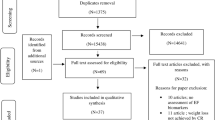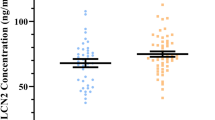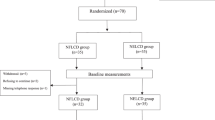Abstract
Background:
In obesity, metabolic stress and inflammation in injured tissues could favour enhanced shedding of procoagulant microparticles (MPs). At sites of endothelium injury, the swift recruitment of procoagulant leukocyte-derived MPs enables the initiation of blood coagulation and thrombus growth.
Objectives:
In obese females, we sought to evaluate the impact of a very low-calorie diet (VLCD) on procoagulant MP levels, fibrinolytic status, inflammation and endothelium damage.
Methods:
Circulating biomarkers of vascular damage, fibrinolytic status, platelet activation and inflammation were measured before, 30 and 90 days after starting a short-term VLCD. MPs were measured by flow cytometry and capture assays. Their procoagulant potential was quantified using functional prothrombinase assays and their cellular origin were determined using flow cytometry (endothelium, platelet, leukocyte, lymphocyte and erythrocyte-derived MP) or capture assays.
Results:
A total of 24 obese females (39±10 years) with a mean body mass index of 35±4 kg m−2 were prospectively enroled. Procoagulant leukocyte-derived MPs were associated with the waist circumference at baseline (r=0.534; P=0.010) and at 90 days follow-up (r=0.487; P=0.021). At 90 days, weight reduction (−9.8%) was associated with a lowering of blood pressure, improvement of metabolic parameters and a significant reduction of plasminogen activator inhibitor-1 (PAI-1) (−38%), procoagulant platelet-derived MPs (−43%), leukocyte-derived MPs (−28%) and leptin (−32%) levels.
Conclusion:
In obese females, a short-term VLCD results in an overall improvement of the haemostatic balance characterized by the reduction of PAI-levels, diminished release of platelet and leukocyte-derived MPs and a reduction in leptin levels, an adipocyte-derived cytokine.
This is a preview of subscription content, access via your institution
Access options
Subscribe to this journal
Receive 12 print issues and online access
$259.00 per year
only $21.58 per issue
Buy this article
- Purchase on Springer Link
- Instant access to full article PDF
Prices may be subject to local taxes which are calculated during checkout


Similar content being viewed by others
References
Belza A, Toubro S, Stender S, Astrup A . Effect of diet-induced energy deficit and body fat reduction on high-sensitive CRP and other inflammatory markers in obese subjects. Int J Obes (Lond) 2009; 33: 456–464.
Reaven GM, Scott EM, Grant PJ, Lowe GD, Rumley A, Wannamethee SG et al. Hemostatic abnormalities associated with obesity and the metabolic syndrome. J Thromb Haemost 2005; 3: 1074–1085.
Goichot B, Grunebaum L, Desprez D, Vinzio S, Meyer L, Schlienger JL et al. Circulating procoagulant microparticles in obesity. Diabetes Metab 2006; 32: 82–85.
Ueba T, Haze T, Sugiyama M, Higuchi M, Asayama H, Karitani Y et al. Level, distribution and correlates of platelet-derived microparticles in healthy individuals with special reference to the metabolic syndrome. Thromb Haemost 2008; 100: 280–285.
Morel O, Toti F, Hugel B, Bakouboula B, Camoin-Jau L, Dignat-George F et al. Procoagulant microparticles: disrupting the vascular homeostasis equation? Arterioscler Thromb Vasc Biol 2006; 26: 2594–2604.
Alessi MC, Juhan-Vague I . PAI-1 and the metabolic syndrome: links, causes, and consequences. Arterioscler Thromb Vasc Biol 2006; 26: 2200–2207.
Alessi MC, Lijnen HR, Bastelica D, Juhan-Vague I . Adipose tissue and atherothrombosis. Pathophysiol Haemost Thromb 2003; 33: 290–297.
Murakami T, Horigome H, Tanaka K, Nakata Y, Ohkawara K, Katayama Y et al. Impact of weight reduction on production of platelet-derived microparticles and fibrinolytic parameters in obesity. Thromb Res 2007; 119: 45–53.
Freyssinet JM, Dignat-George F . More on: measuring circulating cell-derived microparticles. J Thromb Haemost 2005; 3: 613–614.
Hugel B, Socie G, Vu T, Toti F, Gluckman E, Freyssinet JM et al. Elevated levels of circulating procoagulant microparticles in patients with paroxysmal nocturnal hemoglobinuria and aplastic anemia. Blood 1999; 93: 3451–3456.
Martin SS, Qasim A, Reilly MP . Leptin resistance: a possible interface of inflammation and metabolism in obesity-related cardiovascular disease. J Am Coll Cardiol 2008; 52: 1201–1210.
Qasim A, Mehta NN, Tadesse MG, Wolfe ML, Rhodes T, Girman C et al. Adipokines, insulin resistance, and coronary artery calcification. J Am Coll Cardiol 2008; 52: 231–236.
Singh P, Hoffmann M, Wolk R, Shamsuzzaman AS, Somers VK . Leptin induces C-reactive protein expression in vascular endothelial cells. Arterioscler Thromb Vasc Biol 2007; 27: e302–e307.
Yamagishi SI, Edelstein D, Du XL, Kaneda Y, Guzman M, Brownlee M . Leptin induces mitochondrial superoxide production and monocyte chemoattractant protein-1 expression in aortic endothelial cells by increasing fatty acid oxidation via protein kinase A. J Biol Chem 2001; 276: 25096–25100.
O'Rourke L, Gronning LM, Yeaman SJ, Shepherd PR . Glucose-dependent regulation of cholesterol ester metabolism in macrophages by insulin and leptin. J Biol Chem 2002; 277: 42557–42562.
Bodary PF, Westrick RJ, Wickenheiser KJ, Shen Y, Eitzman DT . Effect of leptin on arterial thrombosis following vascular injury in mice. JAMA 2002; 287: 1706–1709.
Konstantinides S, Schafer K, Koschnick S, Loskutoff DJ . Leptin-dependent platelet aggregation and arterial thrombosis suggests a mechanism for atherothrombotic disease in obesity. J Clin Invest 2001; 108: 1533–1540.
Konstantinides S, Schafer K, Loskutoff DJ . The prothrombotic effects of leptin possible implications for the risk of cardiovascular disease in obesity. Ann N Y Acad Sci 2001; 947: 134–141; discussion 141–142.
Chironi G, Simon A, Hugel B, Del Pino M, Gariepy J, Freyssinet JM et al. Circulating leukocyte-derived microparticles predict subclinical atherosclerosis burden in asymptomatic subjects. Arterioscler Thromb Vasc Biol 2006; 26: 2775–2780.
Falati S, Liu Q, Gross P, Merrill-Skoloff G, Chou J, Vandendries E et al. Accumulation of tissue factor into developing thrombi in vivo is dependent upon microparticle P-selectin glycoprotein ligand 1 and platelet P-selectin. J Exp Med 2003; 197: 1585–1598.
Ramacciotti E, Hawley AE, Farris DM, Ballard NE, Wrobleski SK, Myers Jr DD et al. Leukocyte- and platelet-derived microparticles correlate with thrombus weight and tissue factor activity in an experimental mouse model of venous thrombosis. Thromb Haemost 2009; 101: 748–754.
Morel O, Pereira B, Averous G, Faure A, Jesel L, Germain P et al. Increased levels of procoagulant tissue factor-bearing microparticles within the occluded coronary artery of patients with ST-segment elevation myocardial infarction: role of endothelial damage and leukocyte activation. Atherosclerosis 2009; 204: 636–641.
Helal O, Defoort C, Robert S, Marin C, Lesavre N, Lopez-Miranda J et al. Increased levels of microparticles originating from endothelial cells, platelets and erythrocytes in subjects with metabolic syndrome: relationship with oxidative stress. Nutr Metab Cardiovasc Dis 2010 [E-pub ahead of print 14 April 2010].
Anfossi G, Russo I, Trovati M . Platelet dysfunction in central obesity. Nutr Metab Cardiovasc Dis 2009; 19: 440–449.
Westerbacka J, Yki-Jarvinen H, Turpeinen A, Rissanen A, Vehkavaara S, Syrjälä M et al. Inhibition of platelet-collagen interaction: an in vivo action of insulin abolished by insulin resistance in obesity. Arterioscler Thromb Vasc Biol 2002; 22: 167–172.
Russo I, Traversa M, Bonomo K, De Salve A, Mattiello L, Del Mese P et al. In central obesity, weight loss restores platelet sensitivity to nitric oxide and prostacyclin. Obesity (Silver Spring) 2010; 18: 788–797.
Mause SF, von Hundelshausen P, Zernecke A, Koenen RR, Weber C . Platelet microparticles: a transcellular delivery system for RANTES promoting monocyte recruitment on endothelium. Arterioscler Thromb Vasc Biol 2005; 25: 1512–1518.
Collet JP, Montalescot G, Vicaut E, Ankri A, Walylo F, Lesty C et al. Acute release of plasminogen activator inhibitor-1 in ST-segment elevation myocardial infarction predicts mortality. Circulation 2003; 108: 391–394.
Hamsten A, de Faire U, Walldius G, Dahlén G, Szamosi A, Landou C et al. Plasminogen activator inhibitor in plasma: risk factor for recurrent myocardial infarction. Lancet 1987; 2: 3–9.
Cortellaro M, Cofrancesco E, Boschetti C, Mussoni L, Donati MB, Cardillo M et al. Increased fibrin turnover and high PAI-1 activity as predictors of ischemic events in atherosclerotic patients. A case-control study. The PLAT Group. Arterioscler Thromb 1993; 13: 1412–1417.
Arikan H, Koc M, Tuglular S, Ozener C, Akoglu E . Elevated plasma levels of PAI-1 predict cardiovascular events and cardiovascular mortality in prevalent peritoneal dialysis patients. Ren Fail 2009; 31: 438–445.
Bouzeghrane F, Zhang X, Gevry G, Raymond J . Deep vein thrombosis resolution is impaired in diet-induced type 2 diabetic mice. J Vasc Surg 2008; 48: 1575–1584.
Folsom AR, Qamhieh HT, Wing RR, Jeffery RW, Stinson VL, Kuller LH et al. Impact of weight loss on plasminogen activator inhibitor (PAI-1), factor VII, and other hemostatic factors in moderately overweight adults. Arterioscler Thromb 1993; 13: 162–169.
Juhan-Vague I, Morange PE, Alessi MC . The insulin resistance syndrome: implications for thrombosis and cardiovascular disease. Pathophysiol Haemost Thromb 2002; 32: 269–273.
Ferreira AC, Peter AA, Mendez AJ, Mendez AJ, Jimenez JJ, Mauro LM et al. Postprandial hypertriglyceridemia increases circulating levels of endothelial cell microparticles. Circulation 2004; 110: 3599–3603.
Tushuizen ME, Nieuwland R, Rustemeijer C, Hensgens BE, Sturk A, Heine RJ et al. Elevated endothelial microparticles following consecutive meals are associated with vascular endothelial dysfunction in type 2 diabetes. Diabetes Care 2007; 30: 728–730.
Sutherland WH, de Jong SA, Hessian PA, Williams MJ . Ingestion of native and thermally oxidized polyunsaturated fats acutely increases circulating numbers of endothelial microparticles. Metabolism 2001; 59: 446–453.
Motton DD, Mackman N, Tilley RE, Rutledge JC . Postprandial elevation of tissue factor antigen in the blood of healthy adults. Thromb Haemost 2005; 94: 504–509.
Nomura S, Komiyama Y . Shear stress and platelet-derived microparticles. Rinsho Byori 1997; 45: 927–933.
Diehl P, Nagy F, Sossong V, Helbing T, Beyersdorf F, Olschewski M et al. Increased levels of circulating microparticles in patients with severe aortic valve stenosis. Thromb Haemost 2008; 99: 711–719.
Acknowledgements
This work was supported by the PHRC (Programme Hospitalier de Recherche Clinique) regional. VLCD was provided by Insudiet (ZI du Taillis, BP 10006, 49270 Champtoceaux, France). The authors thank Drs Caneva, Perrin and Busch and the dieticians for the clinical supervision of the patients and Dr F McKenna for careful english editing.
Author information
Authors and Affiliations
Corresponding author
Ethics declarations
Competing interests
The authors declare no conflict of interest.
Rights and permissions
About this article
Cite this article
Morel, O., Luca, F., Grunebaum, L. et al. Short-term very low-calorie diet in obese females improves the haemostatic balance through the reduction of leptin levels, PAI-1 concentrations and a diminished release of platelet and leukocyte-derived microparticles. Int J Obes 35, 1479–1486 (2011). https://doi.org/10.1038/ijo.2011.19
Received:
Revised:
Accepted:
Published:
Issue Date:
DOI: https://doi.org/10.1038/ijo.2011.19
Keywords
This article is cited by
-
Effects of Exercise on Extracellular Vesicles in Patients with Metabolic Dysfunction: a Systematic Review
Journal of Cardiovascular Translational Research (2023)
-
Predictors of venous thromboembolism in COVID-19 patients: results of the COVID-19 Brazilian Registry
Internal and Emergency Medicine (2022)
-
Evaluation of all Types of Metabolic Bariatric Surgery and its Consequences: a Systematic Review and Meta-Analysis
Obesity Surgery (2019)
-
The Impact of Vascular Disease Treatment on Platelet-Derived Microvesicles
Cardiovascular Drugs and Therapy (2017)
-
Dynamics of circulating microparticles in obesity after weight loss
Internal and Emergency Medicine (2016)



